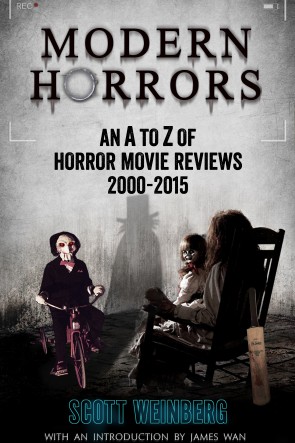Review: FEAR ITSELF (2015){0}
Fear itself: not actually, as it turns out, the only thing to fear.
It starts (and ends) with a window. We are inside, in shadow, looking out – at a low angle, as though in a bed or on the floor – at the upper windows and roofs of the dusk- (or is it dawn-?)lit houses opposite in which, perhaps, similar people have similar prospects. It is an ordinary image of residential banality – but it also, with its its lack of context and its frame (the window) both focusing and occluding our view, an image that foregrounds the very act of seeing, and more importantly of seeing a reality beyond the darkness.
That, in essence, is also what Fear Itself strives to do. Critic Charlie Lyne’s debut Beyond Clueless (2014), a dreamy film essay on adolescence as it is filtered through (mostly Nineties) teen flicks, featured a disproportionate number of horror titles to hammer home its thesis, and here his love for the genre is given free rein as he teases out what films that exploit, amplify and excite our fears have to say about us. In other words, he is interested in that shadowy area where the framed fantasy ends and the reality begins. Accordingly, those opening and closing images of the window are the only ‘real’, contemporary shots that we see in the film – everything in between is ‘found footage’ lifted from an eclectic range of horror titles (all conveniently captioned for the terror trainspotter) to illustrate the narrator’s ruminations on fear.
Even the very identity of this narrator (voiced by Amy E. Watson) negotiates the territory between tall tales and true. For though she relates her horror viewing to her recent real-life experiences of a car accident and the loss of a loved one – much as she considers certain films in terms of their production history or their connection to real stories – she is in fact herself a fiction, her words and backstory the pure invention of Lyne. It is difficult to locate precisely where the truth lies, but then, that is also the case with the horror genre – or more broadly, with cinema itself – which though rooted (mostly) in make believe, elicits intellectual and emotional responses from the viewer that are real enough.
The first excerpted sequence in Fear Itself is the (slasher) film-within-a-film in Blow Out (1981) – itself a reimagining of Blow Up (1966) – which immediately places us in the reflective realm of metacinema. This is a film about film, and although it does not really aim to be frightening like the movies it shows and discusses, it nonetheless distinguishes itself from Beyond Clueless by including no short clips or rapid montages of scenes from different films, instead giving each clip time to breathe and build, so that the fear they are designed to evoke can become tangible, even at this contemplative remove.
The 82 films pillaged here are richly varied. They come from all over the world, and cover the whole history of the horror genre (going back as far as 1922’s Nosferatu and 1923’s The Hunchback of Notre Dame) – and some are not obviously horror films at all, even if they form a neat part of Lyne’s argument. Few, for example, would claim Gravity (2013) as belonging to the genre, but its closing scene (shown here) does fit easily into a section on our atavistic anxieties about heights and primitive desire for groundedness. Fear is the key here, and films of any kind can provoke it.
As we learn more about the narrator, the selection of films to illustrate her commentary on fear becomes even more self-referential. After, for example, she has told a story about screaming at an insensitive stranger during her sister’s funeral, and related how later someone said that the outburst was “like another me”, we see a clip of murder from Alan Clarke’s Elephant (1989), which doubles, both in its title and in the cool objectivity of its content, Gus van Sant’s Elephant (2003), seen earlier in the film. “Like another me,” indeed. And in a discussion of the way that horror films can be desensitising and “after a while cease to have the same impact they once did”, a clip is shown of the young protagonist in Victor Erice’s The Spirit of the Beehive (1977) watching the very same scene from James Whale’s Frankenstein (1931) that Fear Itself had shown earlier.
“Let me assert my firm belief that the only thing to fear is fear itself,” declared Franklin D. Roosevelt, famously, at his first Presidential inauguration. Despite alluding to this is in his film’s title, Lyne’s conclusion, reached via a complicated free association of observations and anecdotes, is different: he (or at least his narrator) argues that what we have to fear, ultimately, is ourselves, and that it is this aspect of our all-too-human nature that horror both mirrors and manipulates.
★★★★








